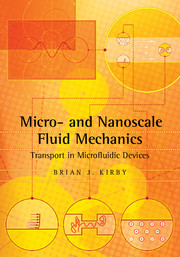Book contents
- Frontmatter
- Contents
- Preface
- Nomenclature
- Introduction
- 1 Kinematics, Conservation Equations, and Boundary Conditions for Incompressible Flow
- 2 Unidirectional Flow
- 3 Hydraulic Circuit Analysis
- 4 Passive Scalar Transport: Dispersion, Patterning, and Mixing
- 5 Electrostatics and Electrodynamics
- 6 Electroosmosis
- 7 Potential Fluid Flow
- 8 Stokes Flow
- 9 The Diffuse Structure of the Electrical Double Layer
- 10 Zeta Potential in Microchannels
- 11 Species and Charge Transport
- 12 Microchip Chemical Separations
- 13 Particle Electrophoresis
- 14 DNA Transport and Analysis
- 15 Nanofluidics: Fluid and Current Flow in Molecular-Scale and Thick-EDL Systems
- 16 AC Electrokinetics and the Dynamics of Diffuse Charge
- 17 Particle and Droplet Actuation: Dielectrophoresis, Magnetophoresis, and Digital Microfluidics
- APPENDIX A Units and Fundamental Constants
- APPENDIX B Properties of Electrolyte Solutions
- APPENDIX C Coordinate Systems and Vector Calculus
- APPENDIX D Governing Equation Reference
- APPENDIX E Nondimensionalization and Characteristic Parameters
- APPENDIX F Multipolar Solutions to the Laplace and Stokes Equations
- APPENDIX G Complex Functions
- APPENDIX H Interaction Potentials: Atomistic Modeling of Solvents and Solutes
- Bibliography
- Index
17 - Particle and Droplet Actuation: Dielectrophoresis, Magnetophoresis, and Digital Microfluidics
Published online by Cambridge University Press: 05 June 2012
- Frontmatter
- Contents
- Preface
- Nomenclature
- Introduction
- 1 Kinematics, Conservation Equations, and Boundary Conditions for Incompressible Flow
- 2 Unidirectional Flow
- 3 Hydraulic Circuit Analysis
- 4 Passive Scalar Transport: Dispersion, Patterning, and Mixing
- 5 Electrostatics and Electrodynamics
- 6 Electroosmosis
- 7 Potential Fluid Flow
- 8 Stokes Flow
- 9 The Diffuse Structure of the Electrical Double Layer
- 10 Zeta Potential in Microchannels
- 11 Species and Charge Transport
- 12 Microchip Chemical Separations
- 13 Particle Electrophoresis
- 14 DNA Transport and Analysis
- 15 Nanofluidics: Fluid and Current Flow in Molecular-Scale and Thick-EDL Systems
- 16 AC Electrokinetics and the Dynamics of Diffuse Charge
- 17 Particle and Droplet Actuation: Dielectrophoresis, Magnetophoresis, and Digital Microfluidics
- APPENDIX A Units and Fundamental Constants
- APPENDIX B Properties of Electrolyte Solutions
- APPENDIX C Coordinate Systems and Vector Calculus
- APPENDIX D Governing Equation Reference
- APPENDIX E Nondimensionalization and Characteristic Parameters
- APPENDIX F Multipolar Solutions to the Laplace and Stokes Equations
- APPENDIX G Complex Functions
- APPENDIX H Interaction Potentials: Atomistic Modeling of Solvents and Solutes
- Bibliography
- Index
Summary
Microsystems use several techniques to actuate particles beyond the electrophoresis discussed in Chapter 13. Two physical phenomena are described in this chapter – dielectrophoresis and magnetophoresis – which are commonly used in microdevices to manipulate particles or droplets in suspension. This chapter also discusses digital microfluidics, which is not a physical phenomenon, but rather a system concept for manipulating fluid droplets using AC electric fields.
DIELECTROPHORESIS
Dielectrophoresis (DEP) is often used in microsystems as a mechanism for manipulating particles. It is appealing because the dielectrophoretic force on a particle scales with the characteristic length scale of the system to the –3 power, and dielectrophoretic forces are quite large when small devices are used. Further, particle response varies based on the frequency and phase of the applied field. Because the user can change particle response by changing a setting on a function generator, DEP measurements afford great flexibility to the user. Because of this, DEP has been used for many applications, with one example shown in Fig. 17.1.
The term dielectrophoresis refers to the Coulomb response of an electrically polarized object in a nonuniform electric field. In contrast to linear electrophoresis, it (a) does not require that the object have a net charge and (b) has a nonzero time-averaged effect even if AC electric fields are used.
Consider, as an example, a spherical, uncharged, uniform, ideal dielectric particle with a finite polarizability, expressed using its electrical permittivity εp, suspended in empty space.
- Type
- Chapter
- Information
- Micro- and Nanoscale Fluid MechanicsTransport in Microfluidic Devices, pp. 373 - 404Publisher: Cambridge University PressPrint publication year: 2010



